2024届高考英语二轮复习语法之定语从句课件(共24张PPT)
文档属性
| 名称 | 2024届高考英语二轮复习语法之定语从句课件(共24张PPT) |  | |
| 格式 | pptx | ||
| 文件大小 | 3.9MB | ||
| 资源类型 | 教案 | ||
| 版本资源 | 通用版 | ||
| 科目 | 英语 | ||
| 更新时间 | 2024-02-18 21:33:44 | ||
图片预览

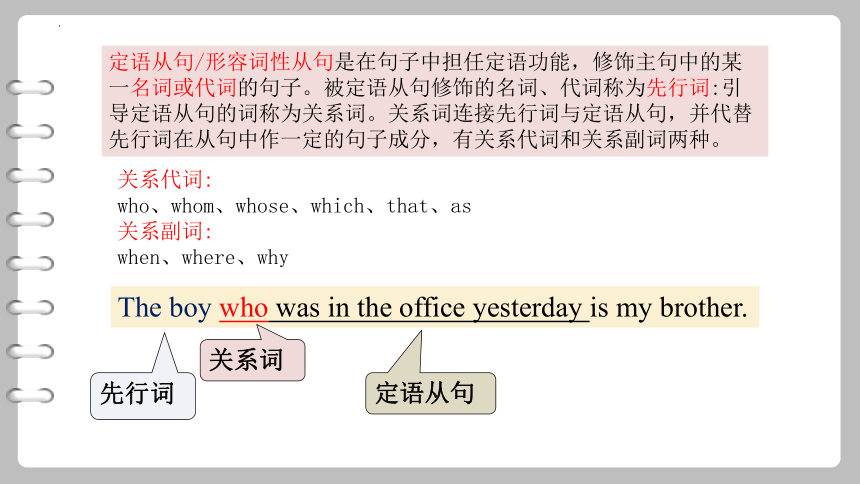
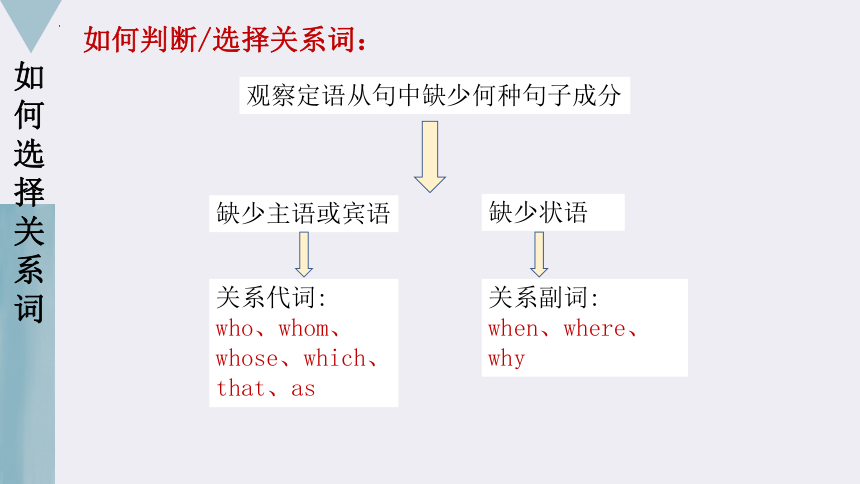
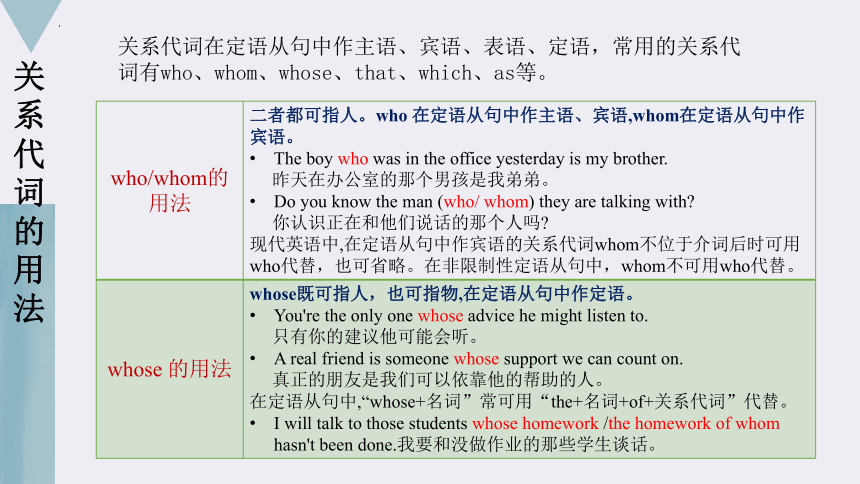
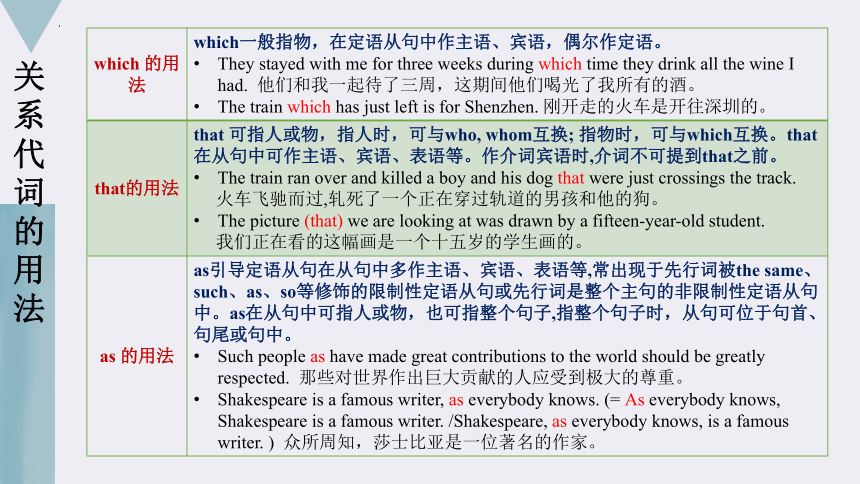
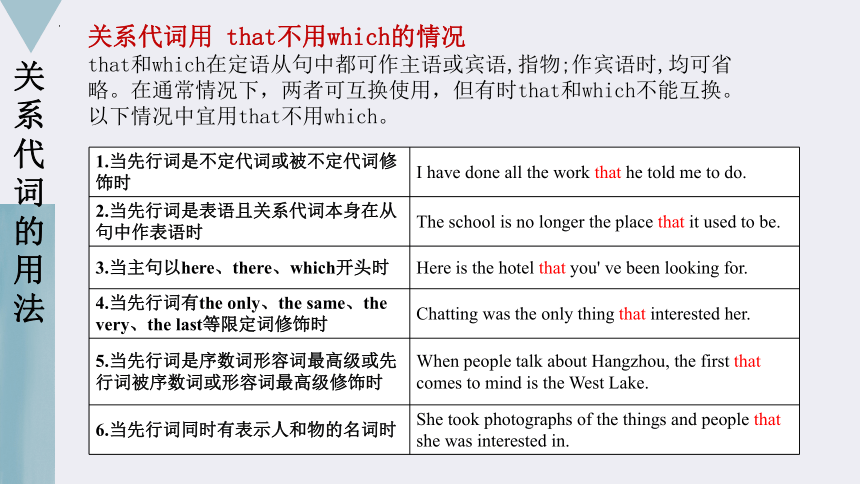



文档简介
(共24张PPT)
定语从句
定语从句/形容词性从句是在句子中担任定语功能,修饰主句中的某一名词或代词的句子。被定语从句修饰的名词、代词称为先行词:引导定语从句的词称为关系词。关系词连接先行词与定语从句,并代替先行词在从句中作一定的句子成分,有关系代词和关系副词两种。
关系代词:
who、whom、whose、which、that、as
关系副词:
when、where、why
The boy who was in the office yesterday is my brother.
关系词
先行词
定语从句
如何选择关系词
如何判断/选择关系词:
观察定语从句中缺少何种句子成分
缺少主语或宾语
缺少状语
关系代词:
who、whom、whose、which、that、as
关系副词:
when、where、why
关系代词的用法
关系代词在定语从句中作主语、宾语、表语、定语,常用的关系代词有who、whom、whose、that、which、as等。
who/whom的用法 二者都可指人。who 在定语从句中作主语、宾语,whom在定语从句中作宾语。
The boy who was in the office yesterday is my brother.
昨天在办公室的那个男孩是我弟弟。
Do you know the man (who/ whom) they are talking with
你认识正在和他们说话的那个人吗
现代英语中,在定语从句中作宾语的关系代词whom不位于介词后时可用who代替,也可省略。在非限制性定语从句中,whom不可用who代替。
whose 的用法 whose既可指人,也可指物,在定语从句中作定语。
You're the only one whose advice he might listen to.
只有你的建议他可能会听。
A real friend is someone whose support we can count on.
真正的朋友是我们可以依靠他的帮助的人。
在定语从句中,“whose+名词”常可用“the+名词+of+关系代词”代替。
I will talk to those students whose homework /the homework of whom hasn't been done.我要和没做作业的那些学生谈话。
关系代词的用法
which 的用法 which一般指物,在定语从句中作主语、宾语,偶尔作定语。
They stayed with me for three weeks during which time they drink all the wine I had. 他们和我一起待了三周,这期间他们喝光了我所有的酒。
The train which has just left is for Shenzhen. 刚开走的火车是开往深圳的。
that的用法 that 可指人或物,指人时,可与who, whom互换; 指物时,可与which互换。that 在从句中可作主语、宾语、表语等。作介词宾语时,介词不可提到that之前。
The train ran over and killed a boy and his dog that were just crossings the track.
火车飞驰而过,轧死了一个正在穿过轨道的男孩和他的狗。
The picture (that) we are looking at was drawn by a fifteen-year-old student.
我们正在看的这幅画是一个十五岁的学生画的。
as 的用法 as引导定语从句在从句中多作主语、宾语、表语等,常出现于先行词被the same、such、as、so等修饰的限制性定语从句或先行词是整个主句的非限制性定语从句中。as在从句中可指人或物,也可指整个句子,指整个句子时,从句可位于句首、句尾或句中。
Such people as have made great contributions to the world should be greatly respected. 那些对世界作出巨大贡献的人应受到极大的尊重。
Shakespeare is a famous writer, as everybody knows. (= As everybody knows, Shakespeare is a famous writer. /Shakespeare, as everybody knows, is a famous writer. ) 众所周知,莎士比亚是一位著名的作家。
关系代词的用法
关系代词用 that不用which的情况
that和which在定语从句中都可作主语或宾语,指物;作宾语时,均可省略。在通常情况下,两者可互换使用,但有时that和which不能互换。以下情况中宜用that不用which。
1.当先行词是不定代词或被不定代词修饰时 I have done all the work that he told me to do.
2.当先行词是表语且关系代词本身在从句中作表语时 The school is no longer the place that it used to be.
3.当主句以here、there、which开头时 Here is the hotel that you' ve been looking for.
4.当先行词有the only、the same、the very、the last等限定词修饰时 Chatting was the only thing that interested her.
5.当先行词是序数词形容词最高级或先行词被序数词或形容词最高级修饰时 When people talk about Hangzhou, the first that comes to mind is the West Lake.
6.当先行词同时有表示人和物的名词时 She took photographs of the things and people that she was interested in.
关系代词的用法
关系代词用 which不用that的情况
1.引导非限制性定语从句时 The longests track and field event at the Summer Olympics is the 50 kilometer race walk, which is about five miles longer than the marathon.
夏季奥运会最长的田轻项目是50千米竞走,它比马拉松长约5英里。
2.在定语从句中作介词的宾语,且介词位于关系代词之前时 I'm looking for a container in which I can put all these coins.
我正在找一个能盛下所有这些硬币的容器。
关系代词的用法
关系代词用 who不用that的情况
当先行词指人时,关系代词既可以用who,也可以用that,但who不能在从句中作表语,而that不能引导非限制性定语从句。
1.先行词为指人的one、 ones、anyone或those时 Anyone who failed to come to the meeting yesterday must give his reason.
凡是昨天没来开会的人必须陈述理由。
2.存现句中,主语是指人的名词时 There's a gentleman who wants to see you.
有位先生想要见你。
3.先行词有较长的后置定语时 Do you know the writer in blue with thick gasses who is speaking at the meeting
你认识穿蓝衣服、戴高度近视镜在会上讲话的那位作家吗
4.两个定语从句中一个用了that,另一个指人的关系代词用who The student that was praised at yesterday's meeting is the monitor who is very modest and works very hard
昨天在会上受到表扬的学生是位谦虚好学的班长。
关系代词的用法
关系代词用that不用who的情况
1.当主句是以who开头的特殊疑问句时 Who was the man that you danced with last night
昨天晚上和你一起跳舞的那个人是谁
2.当先行词前有the same、形容词最高级、序数词、the last,only等词修饰时 He is the last man that I want to see. 他是我最不想见的一个人。
关系副词的用法
关系副词在定语从句中作状语,常用的关系副词有where、when、why等。
where代替表示地点的先行词,在定语从句中作地点状语,此时常可用in which、on which、at which, to which等取代。 Nowadays people are more concerned about the environment where they live.
现在人们对他们所居住地的环境更为关心了。
Many countries are now setting up national parks where/ in which animals and plants can be protected.许多国家都在建立国家公园,在那里动植物可以受到保护。
when代替表示时间的先行词,在定语从句中作时间状语,此时常可用on which、in which、at which、during which等代替。 September 30 is the day when/by which you must pay your bill. 9月30日是你必须付账单的时间。
I shall never forget the days when/in which we worked on the farm.
我永远也不会忘记我们在农场工作的那些日子。
why 一般跟在先行词reason后,在定语从句中作原因状语,可以用for which代替。引导非限制性定语从句时不能用why,但可用for which。 I have come around to explain the reason why/ for which I was absent from the meeting.
我来是为了解释我没有参加会议的原因。
Can you tell me the reason why/ for which the car broke down 你能告诉我汽车坏了的原因吗
介词+关系代词结构
“介词十关系代词”型 There used to be a time at which during which the Chinese people struggled for freedom.
中国人曾有过一段为自由而斗争的日子。
I'd like you to explain the reason for which you were absent.
我想让你解释一下你没来的原因。
“代词/数词/形容词最高级十介词+关系代词”结构 Here are the questions, some of which/of which some I thought too difficult for you,
就是这些问题,其中一些我认为对你来说太难。
Last Sunday I bought some books from the bookstore, three of which were English novels.
上星期天我从书店买回一些书,其中有三本英文小说。
He has six daughters, the tallest of whom is Lily.
他有六个女儿,其中最高的是莉莉。
“介词+关系代词”结构
有时从句中的介词会移到关系代词之前,此时关系代词用which、whom、whose。
介词+关系代词结构
关系代词前介词的确定
1.依据定语从句中动词所需要的某种习惯搭配来确定 Indeed, his slim but strong body is just like that of millions of Chinese farmers, to whom he has devoted his life.
确实,他瘦削但结实的身躯看起来和他为之奉献了一生的千千万万的中国农民一样。
2.依据先行词的某种习惯搭配来确定 I'll never forget the time during which I spent my childhood in the country.
我永远不会忘记孩童时期我在乡村度过的时光。
3.根据句子所表达的意思来确定 The colourless gas without which we cannot live is called oxygen.
离开它我们不能活的这种无色气体称为氧气。
限制性定语从句与非限制性定语从句
根据定语从句与先行词之间的关系紧密程度,可以将定语从句分为限制性定语从句和非限制性定语从句。
限制性定语从句用来修饰和限制先行词,与先行词之间的关系非常密切,它所修饰的先行词代表一个、一些或一类特指的人或物,说明先行词的性质、身份、特征等状况。如果去掉限制性定语从句,原句意思会含糊不清。
A nurse is a person who looks after patients.
护士是照顾病人的人。
She has found the necklace that she lost two weeks ago.
她找到了两周前丢失的那条项链。
限制性定语从句与非限制性定语从句
非限制性定语从向起补充说明的作用,去掉也不会影响对全句的理解。非限制性定课从句的前面往往有逗号与先行词隔开,若将非限制性定语从句放在句子中间,其前路都需要用逗号隔开。
In the beginning, Tu Youyou went to Hainan, where malaria was more common, to study malaria patients.
在开始的时候,屠呦呦去了海南研究疟疾患者,在那里疟疾较为普遍。
Tom's father, who is over sixty, still works hard day and night.
汤姆的父亲已经六十多岁了,他仍然从早到晚努力工作着。
非限制性定语从句
非限制性定从
使用非限制性定语从句的情况
当关系代词指代整个主句的内容时 She said she had finished her work, which I doubted very much. 她说她已经完成了工作,我对此深感怀疑。
As most people know, Fujian is famous for its tea.
正如大多数人所知,福建以茶闻名。
当先行词指的是世界上独一无二的事物或专有名词时 The moon, which is 384,400 kilometres away from the earth, creates many beautiful stories.
月球,这个离地球384,400千米远的球体,创造了很多美好的故事。
先行词指的是某人仅有的一个亲属时 My father, who is an excellent violinist, is giving a concert next month.
我爸爸下个月准备开一场音乐会,他是一一名出色的小提琴手。
“名词/数词/代词+介词+关系代词”结构常用非限制性定语从句 I have three foreign teachers, two of whom are from Canada.
我有三个外籍老师,其中两个来自加拿大。
非限制性定从
限制性定语从句与非限制性定语从句的区别
区别点 限制性定语从句 非限制性定语从句
与先行词的关系 紧密,删除后影响整个主句意义的表达 疏松,只是补充说明,删除后不影响整个主句意义的表达
逗号的有无 其前不用逗号 其前有逗号
that的使用 可用 不可用
which/who在从句中作宾语时是否可省略 可省略 不可省略
Whom在从句中作宾语时是否可用that或who替代 可替代 不可替代
读时是否停顿 不停顿 读时停顿,用降调
是否可修饰主句 不可 可修饰整个句子,只能由which或as引导
翻译时的区别 常译为定语 常译为并列的句子
as和which引导非限制性定语从句的用法辨析
非限制性定从
关系代词as与which引导非限制性定语从句时,可以用整个主句作为其先行词,指代上文或下文所说的一件事。但as和which具有不同的意义,句法和用法也存在差别。
1.as引导的从句表示说话人对话语的看法、态度、解释或评论 She is very patient, as is shown in her work.
她很有耐心,正如她在工作中所表现出来的一样。
There was a net bar around here, as I remember.
我记得这附近有一家网吧。
2.as从句可以位于句首、句尾或句中,which从句只能位于句尾 As can be seen, oceans cover more than 70% of the earth.
正如我们所看到的,大洋占了地球面积的70%还多。
The naughty boy is always knocking at my door,which annoys me very much.
那个调皮的小男孩老是敲我的门,这让我很恼火。
as和which引导非限制性定语从句的用法辨析
非限制性定从
3.which引导的非限制性定语从句对主句所叙述的事情进行补充说明,表明事物存在的状态或引起的结果 The boy had a fever every night, which worried his parents very much.
这个男孩每晚都发烧,这使他的父母非常担心。
4. which在句法上一般用作实义动词的主语,这时它所引导的从句与主向之间常是并列、因果关系 I bought my sister a big toy, which delighted her greatly. (= I bought my sister a big toy, and that delighted her greatly. )我给妹妹买了一个大玩具,这使她非常高兴。
5.不能省去非限制性定语从句中的动词be时,用which,反之则用as Jane told me she won the match, which was a lie,
简告诉我她赢了这场比赛,这是一个谎言。(was 不可省略)
As (was) planned, we met at the airport.
按照计划,我们在机场见了面。(was 可省略)
6.当从句的谓语动词是否定形式或从句谓语动词后有复合宾语时,一般用which不用as You pretended not to know me, which I didn't understand. 你假装不认识我,这令我不明白。
He dislikes everyone in the class, which 1 think quite strange. 他不喜欢班里的每个人,我认为这太奇怪了。
定语从句与同位语从句的区别
that引导的定语从句与同位语从句的区别
1.所表达的内容不同 定语从句和同位语从句都可以用来修饰名词。定语从句是用来说明名词的性质、特征、来源等;同位语从句则用来说明名词所表示的具体内容。 The fact that he presented was a strong proof.
他所陈述的事实是一个强有力的证据。(定语从句,说明fact 的来源)
The fact that she hadn't said anything surprised us all.
她什么也没说的事实让我们大家都很惊讶。(同位语从句,说明fact 的内容)
2.that在句中所起的作用不同 引导定语从句的that是关系代词,它的作用是连接主句和从句,并代表先行词在从句中充当句子成分;而且that 在定语从句中作宾语时可省略,指物时,可以用which代替。引导同位语从句的that是连词,只起连接主句和从句的作用,它不充当任何成分,不能省略,也不可被which代替。 The news (that/ which) we heard spread all over the city.
我们所听到的消息传遍了整个城市。(定语从句)
We expressed the hope that Mr and Mrs Smith would come to visit China the next year.
我们表达了希望史密斯夫妇第二年到中国来访的愿望。(同位语从句)
定语从句与同位语从句的区别
that引导的定语从句与同位语从句的区别
3.连用的名词不同 与同位语从句连用的名词数量有限,往往是含有某种信息的词,如message、news、 fact、hope、desire、problem、idea、suggestion、advice、question、order、belief、doubt、fear、truth、thought等,而作定语从句的先行词的名词无此限制。 We are not looking into the question whether he is worth trusting.
他是否值得信赖的问题不是我们正在调查的。(同位语从句)
After this he is not the man that he used to be.
经过了这次事件之后,他已经不是原来的他了。(定语从句)
4.判断定语从句和同位语从句的方法凡是同位语从句,改为The fact/ news/ idea/ order/ truth/ thought is/ was...结构时,从语法及语意上都讲得通,而定语从句则不可。 The news that our team won the game excited us all.我们队赢了比赛的消息使我们每个人都很兴奋。("The news is that our team won the game.”是正确的。that 引导的是同位语从可)
The news that the radio broadcast this morning is not true at all,今天早晨收音机播报的新闻根本不是真的。(不可改为“The news was that the radio broadcast.. ”,that引导的是定语从句)
定语从句与同位语从句的区别
when、 where、why引导的定语从句与同位语从句的区别
when、where、why引导定语从句时,先行词是表示时间、地点、原因的名词,关系词在从句中作状语: 同位语从句中的when、where、why等也在从句中作状语,但有疑问意义而且前面的名词不是表示时间、地点、原因的。
I will remember the time when I won the prize in the National Maths Competition forever.
我将永远记住我在全国数学竞赛中获奖的那刻。 (定语从句)
We haven't settled the question when we should start.
我们应该什么时候动身的问题还没解决。(同位语从句)
I have no idea why he was late.
我不知道他为什么迟到了。(同位语从句)
Do you know the reason why he was late
你知道他为什么迟到了吗 (定语从句)
注意
主谓一致问题
1.关系代词在定语从句中作主语时,定语从向中谓语动词的形式取决于先行词。先行词是单数时,从句的谓语动词用用单数形式;先行词是复数时,从句的谓语动词用复数形式
Mr. Smith, who is now downstairs is asking to see you.
史密斯先生要见你,他现在正在楼下。
The Smiths, who are now downstairs, are asking to see you.
史密斯夫妇一家要见你,他们正在楼下。
2.定语从句前为“one of+可数名词复数”形式时,关系代词作主语,谓语动词用复数形式;定语从向前是"the only one of+可数名词复数”形式时,关系代词作主语,谓语动词用单数形式
Jeff is one of the students who were awarded.
杰夫是当时获奖的学生之一。
Jeff is the only one of the students who was awarded.
杰夫是这些学生当中唯一获奖的。
注意
the same…as/ that…, such…as/ that…
the same... as...引导的定语从句侧重相似性, 意为“如.....样的”;
the same...that... 引导的定语从句往往侧重同一对象
I bought the same dictionary as you bought.
我买了一本和你买的一样的词典。
I met the same person that I saw yesterday.
我遇见了昨天看见的那个人。
2. such...as...中as引导定语从句,as在从句中作主语、宾语等;such... that... 中that引导结果状语从句,从句不缺少句子成分
They had such a fierce dog as I had never seen.他们家有一只我从未 见过的很凶的狗。(as引导定语从句,在从句中作see的宾语)
They had such a fierce dog that no one dared to go near their house.他们有-一只很凶的狗,没人敢靠近他们家。(that 引导结果状语从句,在从句中不作成分)
The End
定语从句
定语从句/形容词性从句是在句子中担任定语功能,修饰主句中的某一名词或代词的句子。被定语从句修饰的名词、代词称为先行词:引导定语从句的词称为关系词。关系词连接先行词与定语从句,并代替先行词在从句中作一定的句子成分,有关系代词和关系副词两种。
关系代词:
who、whom、whose、which、that、as
关系副词:
when、where、why
The boy who was in the office yesterday is my brother.
关系词
先行词
定语从句
如何选择关系词
如何判断/选择关系词:
观察定语从句中缺少何种句子成分
缺少主语或宾语
缺少状语
关系代词:
who、whom、whose、which、that、as
关系副词:
when、where、why
关系代词的用法
关系代词在定语从句中作主语、宾语、表语、定语,常用的关系代词有who、whom、whose、that、which、as等。
who/whom的用法 二者都可指人。who 在定语从句中作主语、宾语,whom在定语从句中作宾语。
The boy who was in the office yesterday is my brother.
昨天在办公室的那个男孩是我弟弟。
Do you know the man (who/ whom) they are talking with
你认识正在和他们说话的那个人吗
现代英语中,在定语从句中作宾语的关系代词whom不位于介词后时可用who代替,也可省略。在非限制性定语从句中,whom不可用who代替。
whose 的用法 whose既可指人,也可指物,在定语从句中作定语。
You're the only one whose advice he might listen to.
只有你的建议他可能会听。
A real friend is someone whose support we can count on.
真正的朋友是我们可以依靠他的帮助的人。
在定语从句中,“whose+名词”常可用“the+名词+of+关系代词”代替。
I will talk to those students whose homework /the homework of whom hasn't been done.我要和没做作业的那些学生谈话。
关系代词的用法
which 的用法 which一般指物,在定语从句中作主语、宾语,偶尔作定语。
They stayed with me for three weeks during which time they drink all the wine I had. 他们和我一起待了三周,这期间他们喝光了我所有的酒。
The train which has just left is for Shenzhen. 刚开走的火车是开往深圳的。
that的用法 that 可指人或物,指人时,可与who, whom互换; 指物时,可与which互换。that 在从句中可作主语、宾语、表语等。作介词宾语时,介词不可提到that之前。
The train ran over and killed a boy and his dog that were just crossings the track.
火车飞驰而过,轧死了一个正在穿过轨道的男孩和他的狗。
The picture (that) we are looking at was drawn by a fifteen-year-old student.
我们正在看的这幅画是一个十五岁的学生画的。
as 的用法 as引导定语从句在从句中多作主语、宾语、表语等,常出现于先行词被the same、such、as、so等修饰的限制性定语从句或先行词是整个主句的非限制性定语从句中。as在从句中可指人或物,也可指整个句子,指整个句子时,从句可位于句首、句尾或句中。
Such people as have made great contributions to the world should be greatly respected. 那些对世界作出巨大贡献的人应受到极大的尊重。
Shakespeare is a famous writer, as everybody knows. (= As everybody knows, Shakespeare is a famous writer. /Shakespeare, as everybody knows, is a famous writer. ) 众所周知,莎士比亚是一位著名的作家。
关系代词的用法
关系代词用 that不用which的情况
that和which在定语从句中都可作主语或宾语,指物;作宾语时,均可省略。在通常情况下,两者可互换使用,但有时that和which不能互换。以下情况中宜用that不用which。
1.当先行词是不定代词或被不定代词修饰时 I have done all the work that he told me to do.
2.当先行词是表语且关系代词本身在从句中作表语时 The school is no longer the place that it used to be.
3.当主句以here、there、which开头时 Here is the hotel that you' ve been looking for.
4.当先行词有the only、the same、the very、the last等限定词修饰时 Chatting was the only thing that interested her.
5.当先行词是序数词形容词最高级或先行词被序数词或形容词最高级修饰时 When people talk about Hangzhou, the first that comes to mind is the West Lake.
6.当先行词同时有表示人和物的名词时 She took photographs of the things and people that she was interested in.
关系代词的用法
关系代词用 which不用that的情况
1.引导非限制性定语从句时 The longests track and field event at the Summer Olympics is the 50 kilometer race walk, which is about five miles longer than the marathon.
夏季奥运会最长的田轻项目是50千米竞走,它比马拉松长约5英里。
2.在定语从句中作介词的宾语,且介词位于关系代词之前时 I'm looking for a container in which I can put all these coins.
我正在找一个能盛下所有这些硬币的容器。
关系代词的用法
关系代词用 who不用that的情况
当先行词指人时,关系代词既可以用who,也可以用that,但who不能在从句中作表语,而that不能引导非限制性定语从句。
1.先行词为指人的one、 ones、anyone或those时 Anyone who failed to come to the meeting yesterday must give his reason.
凡是昨天没来开会的人必须陈述理由。
2.存现句中,主语是指人的名词时 There's a gentleman who wants to see you.
有位先生想要见你。
3.先行词有较长的后置定语时 Do you know the writer in blue with thick gasses who is speaking at the meeting
你认识穿蓝衣服、戴高度近视镜在会上讲话的那位作家吗
4.两个定语从句中一个用了that,另一个指人的关系代词用who The student that was praised at yesterday's meeting is the monitor who is very modest and works very hard
昨天在会上受到表扬的学生是位谦虚好学的班长。
关系代词的用法
关系代词用that不用who的情况
1.当主句是以who开头的特殊疑问句时 Who was the man that you danced with last night
昨天晚上和你一起跳舞的那个人是谁
2.当先行词前有the same、形容词最高级、序数词、the last,only等词修饰时 He is the last man that I want to see. 他是我最不想见的一个人。
关系副词的用法
关系副词在定语从句中作状语,常用的关系副词有where、when、why等。
where代替表示地点的先行词,在定语从句中作地点状语,此时常可用in which、on which、at which, to which等取代。 Nowadays people are more concerned about the environment where they live.
现在人们对他们所居住地的环境更为关心了。
Many countries are now setting up national parks where/ in which animals and plants can be protected.许多国家都在建立国家公园,在那里动植物可以受到保护。
when代替表示时间的先行词,在定语从句中作时间状语,此时常可用on which、in which、at which、during which等代替。 September 30 is the day when/by which you must pay your bill. 9月30日是你必须付账单的时间。
I shall never forget the days when/in which we worked on the farm.
我永远也不会忘记我们在农场工作的那些日子。
why 一般跟在先行词reason后,在定语从句中作原因状语,可以用for which代替。引导非限制性定语从句时不能用why,但可用for which。 I have come around to explain the reason why/ for which I was absent from the meeting.
我来是为了解释我没有参加会议的原因。
Can you tell me the reason why/ for which the car broke down 你能告诉我汽车坏了的原因吗
介词+关系代词结构
“介词十关系代词”型 There used to be a time at which during which the Chinese people struggled for freedom.
中国人曾有过一段为自由而斗争的日子。
I'd like you to explain the reason for which you were absent.
我想让你解释一下你没来的原因。
“代词/数词/形容词最高级十介词+关系代词”结构 Here are the questions, some of which/of which some I thought too difficult for you,
就是这些问题,其中一些我认为对你来说太难。
Last Sunday I bought some books from the bookstore, three of which were English novels.
上星期天我从书店买回一些书,其中有三本英文小说。
He has six daughters, the tallest of whom is Lily.
他有六个女儿,其中最高的是莉莉。
“介词+关系代词”结构
有时从句中的介词会移到关系代词之前,此时关系代词用which、whom、whose。
介词+关系代词结构
关系代词前介词的确定
1.依据定语从句中动词所需要的某种习惯搭配来确定 Indeed, his slim but strong body is just like that of millions of Chinese farmers, to whom he has devoted his life.
确实,他瘦削但结实的身躯看起来和他为之奉献了一生的千千万万的中国农民一样。
2.依据先行词的某种习惯搭配来确定 I'll never forget the time during which I spent my childhood in the country.
我永远不会忘记孩童时期我在乡村度过的时光。
3.根据句子所表达的意思来确定 The colourless gas without which we cannot live is called oxygen.
离开它我们不能活的这种无色气体称为氧气。
限制性定语从句与非限制性定语从句
根据定语从句与先行词之间的关系紧密程度,可以将定语从句分为限制性定语从句和非限制性定语从句。
限制性定语从句用来修饰和限制先行词,与先行词之间的关系非常密切,它所修饰的先行词代表一个、一些或一类特指的人或物,说明先行词的性质、身份、特征等状况。如果去掉限制性定语从句,原句意思会含糊不清。
A nurse is a person who looks after patients.
护士是照顾病人的人。
She has found the necklace that she lost two weeks ago.
她找到了两周前丢失的那条项链。
限制性定语从句与非限制性定语从句
非限制性定语从向起补充说明的作用,去掉也不会影响对全句的理解。非限制性定课从句的前面往往有逗号与先行词隔开,若将非限制性定语从句放在句子中间,其前路都需要用逗号隔开。
In the beginning, Tu Youyou went to Hainan, where malaria was more common, to study malaria patients.
在开始的时候,屠呦呦去了海南研究疟疾患者,在那里疟疾较为普遍。
Tom's father, who is over sixty, still works hard day and night.
汤姆的父亲已经六十多岁了,他仍然从早到晚努力工作着。
非限制性定语从句
非限制性定从
使用非限制性定语从句的情况
当关系代词指代整个主句的内容时 She said she had finished her work, which I doubted very much. 她说她已经完成了工作,我对此深感怀疑。
As most people know, Fujian is famous for its tea.
正如大多数人所知,福建以茶闻名。
当先行词指的是世界上独一无二的事物或专有名词时 The moon, which is 384,400 kilometres away from the earth, creates many beautiful stories.
月球,这个离地球384,400千米远的球体,创造了很多美好的故事。
先行词指的是某人仅有的一个亲属时 My father, who is an excellent violinist, is giving a concert next month.
我爸爸下个月准备开一场音乐会,他是一一名出色的小提琴手。
“名词/数词/代词+介词+关系代词”结构常用非限制性定语从句 I have three foreign teachers, two of whom are from Canada.
我有三个外籍老师,其中两个来自加拿大。
非限制性定从
限制性定语从句与非限制性定语从句的区别
区别点 限制性定语从句 非限制性定语从句
与先行词的关系 紧密,删除后影响整个主句意义的表达 疏松,只是补充说明,删除后不影响整个主句意义的表达
逗号的有无 其前不用逗号 其前有逗号
that的使用 可用 不可用
which/who在从句中作宾语时是否可省略 可省略 不可省略
Whom在从句中作宾语时是否可用that或who替代 可替代 不可替代
读时是否停顿 不停顿 读时停顿,用降调
是否可修饰主句 不可 可修饰整个句子,只能由which或as引导
翻译时的区别 常译为定语 常译为并列的句子
as和which引导非限制性定语从句的用法辨析
非限制性定从
关系代词as与which引导非限制性定语从句时,可以用整个主句作为其先行词,指代上文或下文所说的一件事。但as和which具有不同的意义,句法和用法也存在差别。
1.as引导的从句表示说话人对话语的看法、态度、解释或评论 She is very patient, as is shown in her work.
她很有耐心,正如她在工作中所表现出来的一样。
There was a net bar around here, as I remember.
我记得这附近有一家网吧。
2.as从句可以位于句首、句尾或句中,which从句只能位于句尾 As can be seen, oceans cover more than 70% of the earth.
正如我们所看到的,大洋占了地球面积的70%还多。
The naughty boy is always knocking at my door,which annoys me very much.
那个调皮的小男孩老是敲我的门,这让我很恼火。
as和which引导非限制性定语从句的用法辨析
非限制性定从
3.which引导的非限制性定语从句对主句所叙述的事情进行补充说明,表明事物存在的状态或引起的结果 The boy had a fever every night, which worried his parents very much.
这个男孩每晚都发烧,这使他的父母非常担心。
4. which在句法上一般用作实义动词的主语,这时它所引导的从句与主向之间常是并列、因果关系 I bought my sister a big toy, which delighted her greatly. (= I bought my sister a big toy, and that delighted her greatly. )我给妹妹买了一个大玩具,这使她非常高兴。
5.不能省去非限制性定语从句中的动词be时,用which,反之则用as Jane told me she won the match, which was a lie,
简告诉我她赢了这场比赛,这是一个谎言。(was 不可省略)
As (was) planned, we met at the airport.
按照计划,我们在机场见了面。(was 可省略)
6.当从句的谓语动词是否定形式或从句谓语动词后有复合宾语时,一般用which不用as You pretended not to know me, which I didn't understand. 你假装不认识我,这令我不明白。
He dislikes everyone in the class, which 1 think quite strange. 他不喜欢班里的每个人,我认为这太奇怪了。
定语从句与同位语从句的区别
that引导的定语从句与同位语从句的区别
1.所表达的内容不同 定语从句和同位语从句都可以用来修饰名词。定语从句是用来说明名词的性质、特征、来源等;同位语从句则用来说明名词所表示的具体内容。 The fact that he presented was a strong proof.
他所陈述的事实是一个强有力的证据。(定语从句,说明fact 的来源)
The fact that she hadn't said anything surprised us all.
她什么也没说的事实让我们大家都很惊讶。(同位语从句,说明fact 的内容)
2.that在句中所起的作用不同 引导定语从句的that是关系代词,它的作用是连接主句和从句,并代表先行词在从句中充当句子成分;而且that 在定语从句中作宾语时可省略,指物时,可以用which代替。引导同位语从句的that是连词,只起连接主句和从句的作用,它不充当任何成分,不能省略,也不可被which代替。 The news (that/ which) we heard spread all over the city.
我们所听到的消息传遍了整个城市。(定语从句)
We expressed the hope that Mr and Mrs Smith would come to visit China the next year.
我们表达了希望史密斯夫妇第二年到中国来访的愿望。(同位语从句)
定语从句与同位语从句的区别
that引导的定语从句与同位语从句的区别
3.连用的名词不同 与同位语从句连用的名词数量有限,往往是含有某种信息的词,如message、news、 fact、hope、desire、problem、idea、suggestion、advice、question、order、belief、doubt、fear、truth、thought等,而作定语从句的先行词的名词无此限制。 We are not looking into the question whether he is worth trusting.
他是否值得信赖的问题不是我们正在调查的。(同位语从句)
After this he is not the man that he used to be.
经过了这次事件之后,他已经不是原来的他了。(定语从句)
4.判断定语从句和同位语从句的方法凡是同位语从句,改为The fact/ news/ idea/ order/ truth/ thought is/ was...结构时,从语法及语意上都讲得通,而定语从句则不可。 The news that our team won the game excited us all.我们队赢了比赛的消息使我们每个人都很兴奋。("The news is that our team won the game.”是正确的。that 引导的是同位语从可)
The news that the radio broadcast this morning is not true at all,今天早晨收音机播报的新闻根本不是真的。(不可改为“The news was that the radio broadcast.. ”,that引导的是定语从句)
定语从句与同位语从句的区别
when、 where、why引导的定语从句与同位语从句的区别
when、where、why引导定语从句时,先行词是表示时间、地点、原因的名词,关系词在从句中作状语: 同位语从句中的when、where、why等也在从句中作状语,但有疑问意义而且前面的名词不是表示时间、地点、原因的。
I will remember the time when I won the prize in the National Maths Competition forever.
我将永远记住我在全国数学竞赛中获奖的那刻。 (定语从句)
We haven't settled the question when we should start.
我们应该什么时候动身的问题还没解决。(同位语从句)
I have no idea why he was late.
我不知道他为什么迟到了。(同位语从句)
Do you know the reason why he was late
你知道他为什么迟到了吗 (定语从句)
注意
主谓一致问题
1.关系代词在定语从句中作主语时,定语从向中谓语动词的形式取决于先行词。先行词是单数时,从句的谓语动词用用单数形式;先行词是复数时,从句的谓语动词用复数形式
Mr. Smith, who is now downstairs is asking to see you.
史密斯先生要见你,他现在正在楼下。
The Smiths, who are now downstairs, are asking to see you.
史密斯夫妇一家要见你,他们正在楼下。
2.定语从句前为“one of+可数名词复数”形式时,关系代词作主语,谓语动词用复数形式;定语从向前是"the only one of+可数名词复数”形式时,关系代词作主语,谓语动词用单数形式
Jeff is one of the students who were awarded.
杰夫是当时获奖的学生之一。
Jeff is the only one of the students who was awarded.
杰夫是这些学生当中唯一获奖的。
注意
the same…as/ that…, such…as/ that…
the same... as...引导的定语从句侧重相似性, 意为“如.....样的”;
the same...that... 引导的定语从句往往侧重同一对象
I bought the same dictionary as you bought.
我买了一本和你买的一样的词典。
I met the same person that I saw yesterday.
我遇见了昨天看见的那个人。
2. such...as...中as引导定语从句,as在从句中作主语、宾语等;such... that... 中that引导结果状语从句,从句不缺少句子成分
They had such a fierce dog as I had never seen.他们家有一只我从未 见过的很凶的狗。(as引导定语从句,在从句中作see的宾语)
They had such a fierce dog that no one dared to go near their house.他们有-一只很凶的狗,没人敢靠近他们家。(that 引导结果状语从句,在从句中不作成分)
The End
